

Impress Guide 7.2
Chapter 12
User Interface Variants
This document is Copyright © 2021 by the LibreOffice Documentation Team. Contributors are listed below. This document maybe distributed and/or modified under the terms of either the GNU General Public License (https://www.gnu.org/licenses/gpl.html), version 3 or later, or the Creative Commons Attribution License (https://creativecommons.org/licenses/by/4.0/), version 4.0 or later.
All trademarks within this guide belong to their legitimate owners.
|
Peter Schofield |
Vasudev Narayanan |
Rachel Kartch |
First issue of this chapter.
Please direct any comments or suggestions about this document to the Documentation Team’s mailing list: documentation@global.libreoffice.org
Note
Everything sent to a mailing list, including email addresses and any other personal information that is written in the message, is publicly archived and cannot be deleted.
Published November 2021. Based on LibreOffice 7.2.
Some keystrokes and menu items are different on macOS from those used in Windows and Linux. The table below gives some common substitutions for the instructions in this document. For a detailed list, see the application Help.
|
Windows or Linux |
macOS equivalent |
Effect |
|
Tools > Options |
LibreOffice > Preferences |
Access setup options |
|
Right-click |
Control+click or right-click depending on computer setup |
Open a context menu |
|
Ctrl (Control) |
⌘ (Command) |
Used with other keys |
|
F11 |
⌘+T |
Open the Styles deck in the Sidebar |
By default, commands and tools used in LibreOffice Impress are grouped in a user interface consisting of cascading menus and toolbars. The functions and use of these cascading menus and toolbars are described in previous chapters of this user guide.
This chapter describes the user interface variants that are available for LibreOffice Impress. A user then has the option to select the user interface that suits their requirements and methods of creating presentations in LibreOffice Impress.
To select a user interface variant or switch between the user interface variants:
1) Go to View > User Interface on the Menu bar to open the Select Your Preferred User Interface dialog (Figure 1).
2) In UI variants, select one of the variants. An example of the selected variant is shown in the Preview box, along with a short description.
3) Click on Apply to Impress to apply the variant selection to LibreOffice Impress only, or click on Apply to All to apply the user interface variant to all the LibreOffice modules. The LibreOffice window changes to match the selected variant.
4) Click Close to close the dialog.
Note
If the option Enable experimental features has been selected in the Tools > Options > Advanced dialog, several more variants appear in UI variants. Being experimental, these variants are not described in this user guide.
Figure 1: Select Your Preferred User Interface Variant dialog

Figure 2: Standard Toolbar user interface in LibreOffice Impress
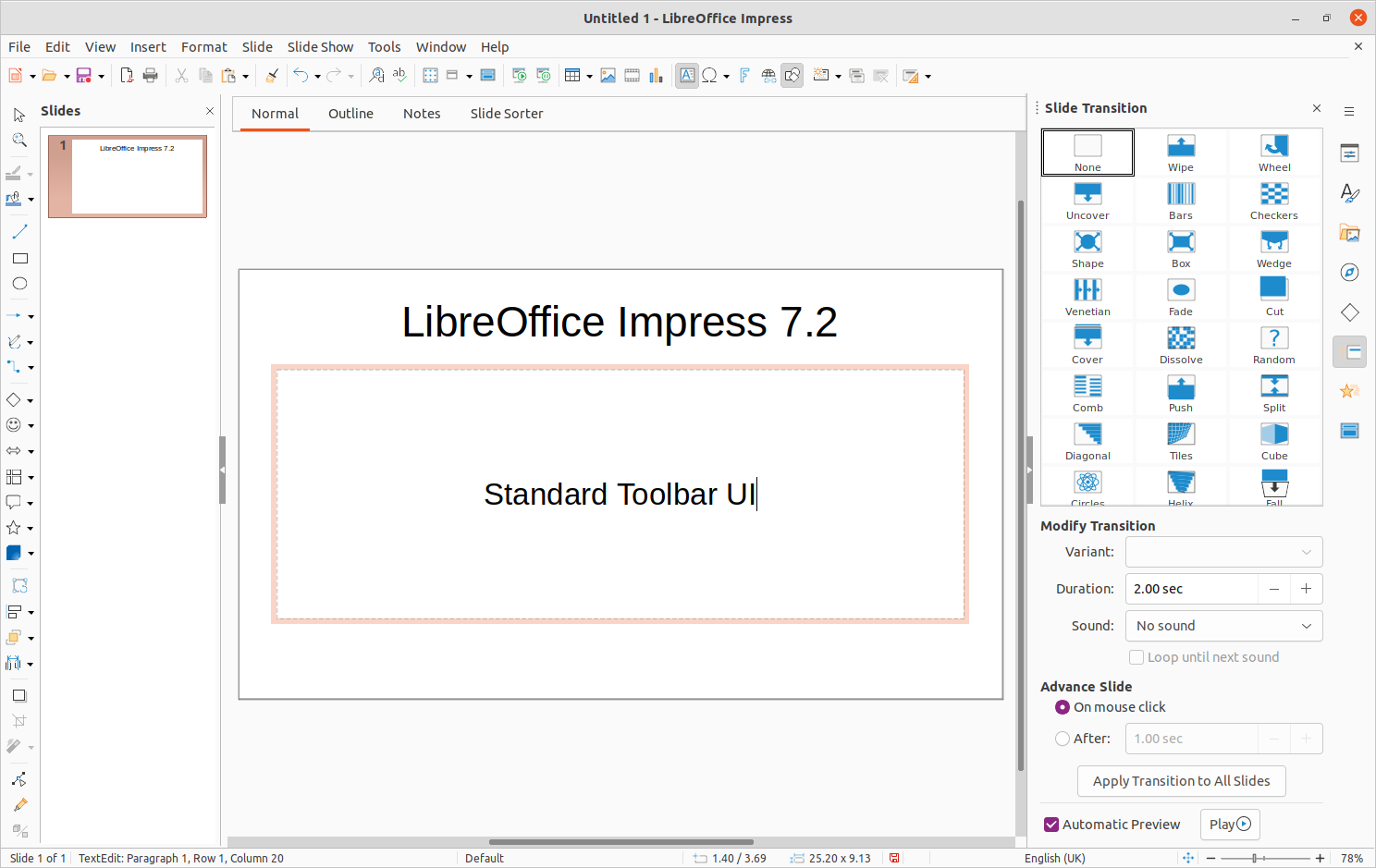
The Standard Toolbar user interface is the default view when LibreOffice is installed and the Workspace opened for the first time. Figure 2 shows an example of the default Workspace view in LibreOffice Impress consisting of the following:
Menu bar at the top of the Workspace.
Standard toolbar positioned below the Menu bar.
Drawing toolbar positioned vertically on the left of the Workspace.
Sidebar on the right of the Workspace.
For more information on the Impress Workspace, see Chapter 1, Introducing Impress.
The Tabbed user interface provides a familiar interface for users coming from proprietary office suites, for example, Microsoft Office. Every tab within this user interface consists of a set of tools grouped by context. The context changes automatically depending on the LibreOffice module and the object selected.
If the tool icons on a tab page do not fit into the width of the Impress window, a double chevron >> appears at the right end of the row. Click the double chevron >> to display more commands.
On Windows and Linux operating systems, the Menu bar can be hidden or displayed by clicking on Menubar at the left end of the Tab bar.
On the right of the Tab bar, a Quick menu (≡) (Figure 3) is available giving access to some commonly used commands and links. Some of the Quick menu items have submenus, indicated by a small triangle ► on the right. The Quick menu is the same for all tabs.
Figure 3: Quick menu options

Figure 4: Icon bar

On the left of the Tab bar, an Icon bar (Figure 4) is available giving access to some commonly used tools – Menubar; Open (Ctrl+O); Save (Ctrl+S);Undo (Ctrl+Z); Redo (Ctrl+Y); Start from First Slide (F5).
The Tabbed user interface can be customized as follows:
1) Click on Quick menu and select Customize from the submenu to open the Customize dialog.
2) Click on Notebookbar to open the Notebookbar page in the Customize dialog.
3) Select or deselect the various tools in Assigned Commands.
4) Click OK to save the changes and close the Customize dialog.
For more information on the customization of LibreOffice, see the Getting Started Guide and the Writer Guide.
Note
When using the Tabbed user interface, the Impress toolbars are no longer visible. If necessary, it is possible to open toolbars by going to View > Toolbars on the Menu bar or Quick menu > Toolbars.
The File tab (Figure 5) is a fixed tab providing a default set of tools, for example, to create new documents; open, save, print, and close documents; manage templates and so on. The File tab has a File menu (Figure 6) and a Help menu (Figure 7) providing links to a variety of resources and containing the same tools as the tools available on the tab.
File tab tools from left to right
New
Open Templates Manager (Shift+Ctrl+N)
Save as Template
Open (Ctrl+O)
Recent Documents
Open Remote File
Save (Ctrl+S)
Save As
Save Remote File
Export
Export Directly as PDF
Attach to Email
Print (Ctrl+P)
Print Directly
Toggle Print Preview (Shift+Ctrl+O)
Properties
Digital Signatures
Sign Existing PDF
Figure 5: Tabbed user interface - File tab

Figure 6: File tab - File menu

Figure 7: File tab - Help menu

The Home tab (Figure 8) is a fixed tab providing a default set of tools, for example, to cut, copy, paste, and format text; insert common items; and so on. The Home menu (Figure 9) at the right end of the Home tab bar provides additional tools that are not on the tab.
Home tab tools from left to right
Paste (Ctrl+V)
Cut (Ctrl+X)
Copy (Ctrl+C)
New Page (Ctrl+M)
Duplicate Page
Delete Page
Slide Layout
Clone Formatting (double click for multi‑selection)
Clear Direct Formatting (Shift+Ctrl+M)
Font Name
Bold (Ctrl+B)
Italic (Ctrl+I)
Underline (Ctrl+U)
Strikethrough
Toggle Shadow
Font Size
Set Character Spacing
Character Highlighting Color
Increase Font Size (Ctrl+])
Decrease Font Size (Ctrl+[)
Font Color
Align Top
Align Left (Ctrl+L)
Center Vertically
Align Center (Ctrl+E)
Align Bottom
Align Right (Ctrl+R)
Toggle Unordered List
Justified (Ctrl+J)
Toggle Ordered List
Set Line Spacing
Increase Indent
Increase Paragraph Spacing
Decrease Indent
Decrease Paragraph Spacing
Left-To-Right
Right-To-Left
Insert Text Box (F2)
Insert Vertical Text
Insert Line
Rectangle
Curves and Polygons
Basic Shapes
Connectors
Flowchart
Line Color
Fill Color
Start from First Slide (F5)
Start from Current Slide (Shift+F5)
Find and Replace (Ctrl+H)
Start from First Slide (F5)
Figure 8: Tabbed user interface - Home tab

Figure 9: Home tab - Home menu

The Insert tab (Figure 10) is a fixed tab providing a default set of tools to insert many commonly used items. The Insert menu (Figure 11) at the right end of the Insert tab bar provides some of the same tools.
Insert tab tools from left to right
New Page (Ctrl+M)
Duplicate Page
Insert Page from File
Table
Insert Chart
OLE Object
Insert Image
Open Clip Art and Media Gallery
Photo Album
Insert Audio or Video
Insert Hyperlink (Ctrl+K)
Insert Fontwork Text
Insert Snap Guide
Field
Insert Text Box (F2)
Insert Vertical Text
Insert Line
Rectangle
Polygon
Ellipse
Curve
Callouts
Lines and Arrows
Curves and Polygons
Basic Shapes
Stars and Banners
Symbol Shapes
Callouts
Block Arrows
Flowchart
Connectors
3D Objects
Insert Special Characters
Insert Formula Object (Ctrl+Alt+=)
Insert Emoji
Insert Image
Insert Text Box (F2)
New Page (Ctrl+M)
Figure 10: Tabbed user interface - Insert tab

Figure 11: Insert tab - Insert menu

The Layout tab (Figure 12) is a fixed tab providing a default set of tools to create a slide layout. The Layout menu (Figure 13) at the right end of the Layout tab bar provides some of the same tools.
Layout tab tools from left to right
Page Properties
Header and Footer
Set Background Image
Save Background Image
New Page (Ctrl+M)
Duplicate Page
Delete Page
Rename Page
Hide Slide
Show Slide
Page Up (Shift+Ctrl+Up)
Page Down (Shift+Ctrl+Down)
Change Slide Master
Master Background
Master Objects
Rotate
Align Objects
Arrange
Slide Layout
Figure 12: Tabbed user interface - Layout tab

Figure 13: Layout tab – Layout menu
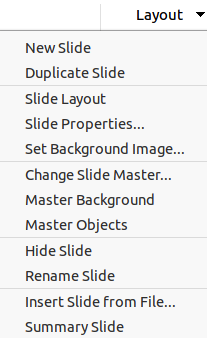
The Slide Show tab (Figure 14) is a fixed tab providing a default set of tools for creating a slide show. The Slide Show menu (Figure 15) at the right end of the Slide Show tab bar provides some of the same tools.
Slide Show tab tools from left to right
Start from First Slide (F5)
Start from Current Slide (Shift+F5)
Rehearse Timings
Custom Slide Show
Slide Show Settings
Slide Transition
Animation
Minimize Presentation
Color
Grayscale
Start from First Slide (F5)
Figure 14: Tabbed user interface - Slide Show tab

Figure 15: Slide Show tab - Slide Show menu
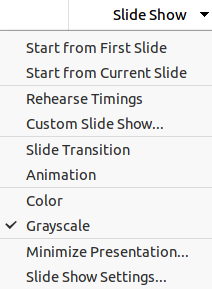
The Review tab (Figure 16) is a fixed tab providing a default set of tools for reviewing a slide show. The Review menu (Figure 17) provides additional text editing tools. Some of these tools appear only if Asian or Complex Text Layout are selected in Tools > Options > Language Settings > Languages.
Review tab tools from left to right
Spelling (F7)
Thesaurus (Ctrl+F7)
Toggle Automatic Spell Checking (Shift+F7)
Hyphenation
Comment (Ctrl+Alt+C)
Next Comment (Ctrl+Alt+Page Down)
Previous Comment (Ctrl+Alt+Page Up)
Delete Comment
Delete All Comments
Comments
Redact Document
Toggle Edit Mode (Shift+Ctrl+M)
Comment (Ctrl+Alt+C)
Figure 16: Tabbed user interface - Review tab

Figure 17: Review tab - Review menu

The View tab (Figure 18) is a fixed tab providing a default set of tools to control the display of slides on a screen. The View menu (Figure 19) provides additional tools relating to the display of slides on a screen.
Top row, left to right
Normal
Slide Sorter
Notes
Outline
Master Slide
Master Notes
Master Handout
Zoom & Pan (Ctrl to Zoom Out, Shift to Pan)
Zoom Previous
Entire Page
Zoom Next
Page Width
Sidebar (Ctrl+F5)
Rulers (Shift+Ctrl+F5)
Display Grid
Menubar
Toggle View Bars Visibility
Figure 18: Tabbed user interface - View tab

Figure 19: View tab - View menu

The Extension tab (Figure 20) is a fixed tab containing only the tool to access the Extension Manager allowing the installation of extensions that are compatible for use in LibreOffice.
Figure 20: Tabbed user interface - Extension tab

The Tools tab (Figure 21) is a fixed tab providing a default set of tools for working with, for example, macros; color replacer; media player; and so on. The Tools menu (Figure 22) provides some of the same tools, plus extra tools for organizing, for example, macros and dialogs; image map; data sources; and so on.
Tools tab tools from left to right
Run Macro
Basic (Alt+F11)
Edit Macros
Minimize Presentation
Color Replacer
Media Player
Design Mode
Toggle Form Control Wizards
Group Box
Label
Option Button
Text Box
List Box
Check Box
Combo Box
Numerical Field
Formatted Field
Currency Field
Date Field
Pattern Field
Time Field
Push Button
File Selection
Image Button
Navigation Bar
Image Control
Table Control
Form Properties
Form Navigator
Activation Order
Open in Design Mode
Control Properties
Automatic Control Focus
Options (Alt+F12)
Figure 21: Tabbed user interface - Tools tab

Figure 22: Tools tab - Tools menu
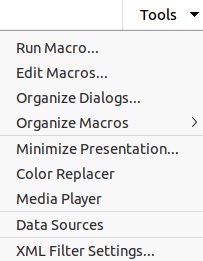
Additional tabs appear between the View and Extension tabs when an object in Impress is selected.
The Draw tab (Figure 23) becomes available when a drawing object is selected in a slide. It provides tools for editing, transforming, grouping, aligning, and distributing draw objects. The Draw tab menu (Figure 24) provides some of the tools required for editing, transforming and converting drawing objects.
Draw tab tools from left to right
Interaction
Transformations
Rotate
Set to Circle (Slant)
Flip
Distort
In 3D Rotation Object
Interactive transparency tool
Set in Circle (perspective)
Rotate
Flip Vertically
Flip Horizontally
Distort
Set to circle (slant)
Line Style
Area
Area Style/Filling
Line Color
Arrow Style
Shadow
To Curve
Left
Top
Centered
Center
Right
Bottom
Bring to Front (Shift+Ctrl++)
Send to Back (Shift+Ctrl+-)
Bring Forward (Ctrl++)
Send Backward (Ctrl+-)
Points (F8)
Convert to Curve
Symmetric Transition
Close Bézier
Eliminate Points
Move Points
Split Curve
Insert Points
Corner Point
Delete Points
Smooth Transition
Show Glue Points Functions
Combine (Shift+Ctrl+K)
Merge
Split (Shift+Ctrl+Alt+K)
Subtract
Select at least three objects to distribute
Intersect
Group (Shift+Ctrl+G)
Enter Group (F3)
Exit Group (Ctrl+F3)
Toggle Extrusion
Depth
Direction
3D Color
Surface
Insert Fontwork Text
Fontwork Shape
Fontwork Alignment
Fontwork Same Letter Heights
Fontwork Character Spacing
Area
Line
Position and Size (F4)
Figure 23: Tabbed user interface - Draw tab

Figure 24: Draw tab - Draw menu
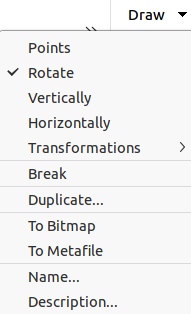
The Image tab (Figure 25) becomes available when an image is selected in a slide, for example a photograph. It provides tools for working with images, such as cropping, borders, area styles, colors, and so on. The Image tab menu (Figure 26) provides links to dialogs for working with images.
Image tab tools from left to right
Interaction
Compress
Rotate
Crop Image
Flip Vertically
Flip Horizontally
Replace
Save
Line
Area
Line Style
Area Style/Filling
Line Width
Line Color
Arrow Style
Shadow
To Curve
Left
Top
Centered
Center
Right
Bottom
Bring to Front (Shift+Ctrl++)
Send to Back (Shift+Ctrl+-)
Bring Forward (Ctrl++)
Send Backward (Ctrl+-)
Filter
Brightness
Contrast
Transparency
Gamma
Image Mode
Color
Area
Line
Position and Size (F4)
Figure 25: Tabbed user interface - Image tab

Figure 26: Image tab - Image menu

The Object tab (Figure 27) becomes available when an object, such as a chart, is selected. It provides tools to position, resize, choose colors, and so on for the selected object. The Object tab menu (Figure 28) provides extra tools matching the type of object selected.
Object tab tools from left to right
Interaction
Transformations
Rotate Flip Vertically
Flip Horizontally
Distort
Set to circle (slant)
Line
Area
Line Style
Area Style/Filling
Line Width
Line Color
Arrow Style
Shadow
To Curve
Left
Top
Centered
Center
Right
Bottom
Bring to Front (Shift+Ctrl++)
Send to Back (Shift+Ctrl+-)
Bring Forward (Ctrl++)
Send Backward (Ctrl+-)
Area
Line
Position and Size (F4)
Figure 27: Tabbed user interface - Object tab

Figure 28: Object tab - Object menu

The Table tab (Figure 29) becomes available when a table is selected in a slide. It provides tools to format a table to the presentation requirements. The Table tab menu (Figure 30) includes extra tools for editing a table.
Table tab tools from left to right
Interaction
Insert Column Before
Insert Row Above
Insert Column After
Insert Row Below
Delete Column
Delete Row
Insert Line
Area
Borders (Shift to overwrite)
Border Style
Area Style/Filling
Border Color
Fill Color
Merge Cells
Split Cells
Select Table
Select Column
Select Row
Optimize
Align Top
Align Left (Ctrl+L)
Center Vertically
Align Center (Ctrl+E)
Align Bottom
Align Right (Ctrl+R)
Right-toLeft
Justified (Ctrl+J)
Table Design
Table Properties
Figure 29: Tabbed user interface - Table tab

Figure 30: Table tab - Table menu
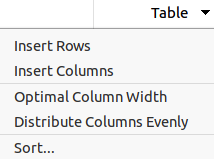
The Media tab (Figure 31) only becomes available when a media object is selected in a slide. It provides tools for positioning and running an audio or video file. The Media tab menu (Figure 32) includes extra tools for editing a media object.
Media tab tools from left to right
Name
Media Player
Rotate
Left
Top
Centered
Center
Right
Bottom
Bring to Front (Shift+Ctrl++)
Send to Back (Shift+Ctrl+-)
Bring Forward (Ctrl++)
Send Backward (Ctrl+-)
Play
Pause
Stop
Repeat
Media Player
Area
Line
Position and Size (F4)
Figure 31: Tabbed user interface - Media tab

Figure 32: Media tab - Media menu

When selected, the Single Toolbar and Sidebar user interfaces only show the Menu bar with no toolbars. However, toolbars can be added to either of these user interfaces by going to View > Toolbars on the Menu bar and selecting the required toolbar from the options available. For more information on toolbars, see Appendix B, Toolbars in this guide and the Getting Started Guide.
The Tabbed Compact user interface has the same tabs as the Tabbed user interface, but the tools on each tab are arranged as a single row of tools. Some of these tools have drop‑down menus with extra options. Figure 33 shows an example of the File tab in the Tabbed Compact user interface.
The tab menu on the right of the Tabbed Compact user interface provides the same options as the tab menus in the Tabbed user interface, see “Tabbed user interface” for more information.
Figure 33: Example of Tabbed Compact user interface showing File tab

The Groupedbar Compact user interface is divided into groups that contain commands organized as sets of tools and menus. The tools and menus that are available change to suit the type of object selected. Clicking on the double chevron >> displays more tools for editing an object. Figure 34 shows an example of Groupedbar Compact user interface when a basic shape object is selected.
The Groupedbar Compact menu (Figure 35) on the right-hand end of this interface provides extra tools for working with LibreOffice Impress, including convenient ways to change the user interface and access toolbars.
Figure 34: Example of Groupedbar Compact user interface with an object selected

Figure 35: Menu for Groupedbar Compact UI
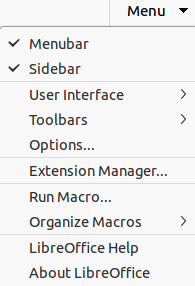
The Contextual Single user interface displays a single toolbar to suit the type of object that has been selected. Clicking on the double chevron >> displays more tools for editing an object. Figure 36 shows an example of a Contextual Single user interface when a basic shape object is selected.
Figure 36: Example of Contextual Single user interface with a basic shape selected
